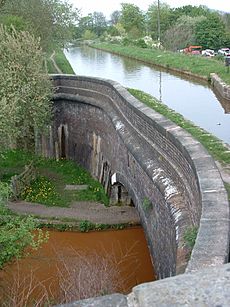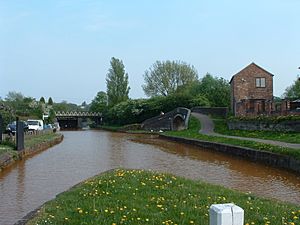Hall Green Branch facts for kids
The Hall Green Branch of the Trent and Mersey Canal is a special waterway in Cheshire, England. It's only about one mile long! This branch connects the Trent and Mersey Canal near Kidsgrove to the Macclesfield Canal at a place called Hall Green. At Hall Green, there's a unique Hall Green Stop Lock that helps manage water levels between the two canals.
Contents
Building the Canal Branch
The Macclesfield Canal was approved by a special law from Parliament on April 11, 1826. But the Trent and Mersey Canal Company made sure a rule was added to this law. This rule said that the Trent and Mersey Company had to build the last mile (about 1.6 kilometers) of the Macclesfield Canal's route.
They also got to charge money (tolls) for boats using this last section. Plus, they could take any extra water from the Macclesfield Canal.
Construction Challenges
Building the branch canal started in 1827. A famous engineer named Thomas Telford checked on the work in 1829. He looked at the Hall Green Branch, the Knypersley Reservoir, and the Harecastle Tunnel.
Telford was mostly happy with the work. But he didn't like that a heavy, blue clay called "dense blue clunch" was used. It was put on top of the special "puddle clay" that keeps the canal watertight. He asked for it to be removed and replaced with gravel.
There were also problems with water leaking into the canal. The engineers tried different ways to fix it. At one point, they even lined about 7 meters (23 feet) of the canal bed with stone slabs. This helped keep the water from bringing sand up, making the canal watertight.
The Macclesfield Canal officially opened on November 9, 1831. The Hall Green Branch started being used on the very same day.
Part of the Macclesfield Canal?
Even though the Trent and Mersey Canal Company built this branch, many maps and guidebooks today show it as part of the Macclesfield Canal. The bridges on the branch are numbered 94 to 98. These numbers follow bridge 93, which is the last bridge on the Macclesfield Canal before the stop lock.
It seems the Macclesfield Canal Company treated it as their own almost from the start. In 1833, they reported building several wharves (places for boats to load and unload goods). One of these was at Hardings Wood, very close to where the branch meets the main Trent and Mersey Canal.
At a place called Poole Lock, the Hall Green Branch actually crosses over the main Trent and Mersey Canal! After about another half-mile (0.8 km), it joins the main canal at Harding Junction. This junction is about 0.75 miles (1.2 km) from the northern entrance of the Harecastle Tunnel.
Hall Green Stop Lock
A stop lock is a special type of lock that helps manage water levels between two different canals. The Hall Green Stop Lock has a small drop of about 12 inches (30 centimeters) from the Macclesfield Canal down to the Trent and Mersey Canal.
Why This Lock is Special
This stop lock was first built with two parts, one after the other. This design allowed for either canal to be higher than the other. However, the second part stopped being used after the canals became owned by the government (nationalisation). The water level on the Trent and Mersey Canal was lowered permanently. This was done to give boats more room to pass under bridges and through the Harecastle Tunnel.
Even though the drop at this lock is small, it's very important and can't be removed. If the water level on the Macclesfield Canal were lowered, boats might have trouble because that canal is already quite shallow. If the water level on the Trent and Mersey Canal were raised, boats would have trouble fitting through the Harecastle Tunnel. In fact, as the Harecastle Tunnel slowly sinks over time, the water level might even be lowered more. This would make the drop at the Hall Green Stop Lock even bigger!



